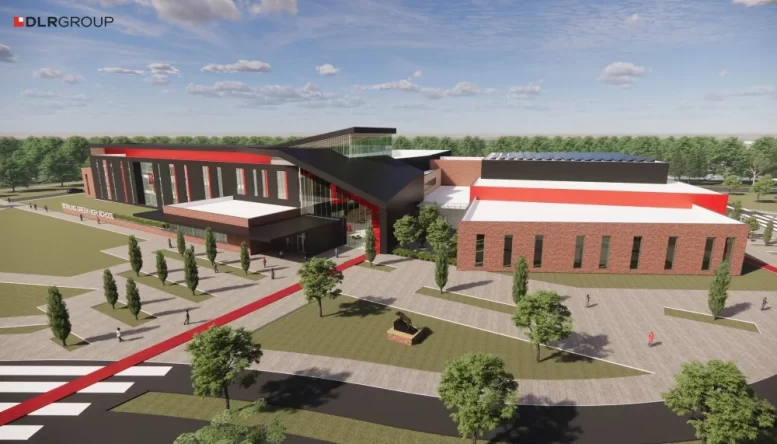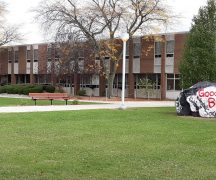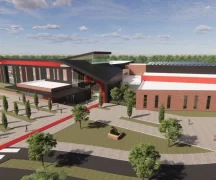By JAN LARSON McLAUGHLIN
BG Independent News
Bowling Green City School District officials have heard the same complaint time and time again. This is bad timing for a school levy.
But when is a good time?
“Over the past several years, there hasn’t seemed to be good timing,” Board of Education President Ryan Myers said earlier this week. Meanwhile, “our students and staff are continuing to go to the same decrepit buildings. They’re not getting better.”
On Tuesday, Nov. 7, voters will decide on a $72.8 million bond issue to build a new Bowling Green High School.
“How much do we want to continue to kick this can down the road?” Myers asked.
Three of the district’s schools, built in the 1960s, are “in hospice,” he said. “It’s not fair to the kids.”
And the longer the can is kicked down the road, the longer the aging Conneaut and Kenwood elementaries will wait for improvements, Myers said.
Superintendent Ted Haselman said school districts that wait for a perfect time will never find one.
“The timing is never perfect to ask people to dig deep into their pockets and pay for schools and other community resources,” Haselman said earlier this week.
Those opposing the bond issue have pointed to the property revaluations done this year that resulted in large jumps in some property values, especially agricultural acreage. But these property revaluations are done on a regular basis, Haselman pointed out, and don’t mean taxes are increasing at the same rate.
“The cost of this levy is not going up by these percentages,” he said.
The superintendent also explained that the levy asks for a specific dollar amount, $72.8 million. So regardless of increases in valuation, that’s the amount it will collect. If property values go up, the millage on the levy goes down to account for that.
Kicking the can will ultimately end up costing the district more. School officials have learned that painful lesson – with the $72.8 million sought seven years ago to build a new high school and elementary, now being enough to pay for just for a new high school.
“Things are never going to get cheaper,” Haselman said.
Bowling Green High School was built in 1963, compared to high school constructions in neighboring districts of Rossford in 2020, North Baltimore in 2012, Otsego in 2007, Elmwood in 2004 and Perrysburg in 2001.
The new BGHS is designed to provide modern teaching and learning space that will serve students into the future.
“That’s our job – to prepare our kids today for their futures,” Haselman said.
The public can view plans for the new BGHS at https://www.bgcs.k12.oh.us/district/superintendent/facilities-planning
The estimated costs of the project are:
- $1.2 million for demolition of the oldest part of the current high school, closest to West Poe Road.
- $5 million for the community activity center, which will include the music areas and practice gymnasiums.
- $824,739 for a new entrance to the music and gym areas.
- $62.3 million for the new high school.
- $3.5 million for a 5% contingency.
According to the Ohio Facilities Construction Commission, it would cost $47.5 million to renovate the existing high school, compared to $64.1 million to build new. Using the OFCC’s threshold for a feasible renovation, the state would not co-fund a renovated BG high school because the costs are too high.
And unlike previous building efforts, this time the district applied for state funding for the new high school. The board was advised it would get a 17% reimbursement of the items OFCC is willing to co-fund. That turns into about $7.5 million that the district would receive when it’s BG’s turn for funding in five to 10 years.
District leaders have worked to eliminate the reasons for voters to reject the bond issue, by addressing past complaints about transparency, trust and questions about building maintenance.
At each board meeting, plus at “coffee chats” in the community, Haselman has answered questions that have been submitted to the district on the bond levy and proposed high school. And community members have been invited to several open tours of the high school.
In response to criticisms in the past about not presenting the community with a design for a new building, the district has repeatedly presented the detailed plans and has made them available on the district website.
“We have been so detail oriented,” Myers said.
As for the trust issue, the district’s new superintendent took over in August, and voters have an opportunity to elect three board members next week.
And in response to complaints that the district does not maintain its buildings well, Haselman could only speak to the future. Any new construction that is part of an Ohio Facilities Construction Commission project is required by OFCC to earmark one-half mill for upkeep and maintenance of the building, he said. These funds are collected and are placed in a special fund that can only be used for upkeep and ongoing maintenance of the new building.
Haselman said he views the upkeep of such community investments as a high priority. His building maintenance philosophy is “no shortcuts, and no Bandaids.”
“I can’t speak to what’s happened in the past, but I give the community my word,” he said. “We will maintain the buildings so they are top notch.”





